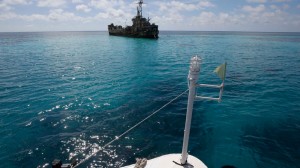More blockades by China to follow, say experts
MANILA, Philippines—Security experts believe China is pushing the region to the “brink of miscalculations” in the South China Sea with its expansive land reclamation in disputed territories as the Philippines anticipates more blockades by the Chinese in the West Philippine Sea once their facilities become fully operational next year.
“The bases are being constructed very fast, done rapidly, that it’s estimated that they would be operational by next year,” military historian Jose Antonio Custodio told the Inquirer in a recent interview.
Custodio said the airfields and naval facilities built by China on reclaimed land on the reefs and atolls along the so-called nine-dash line would allow them to execute more blockades against other claimants in the South China Sea.
Custodio said the Philippine military would have a more difficult time resupplying the Marine platoon posted at Ayungin Shoal (Second Thomas Shoal), which China also claims.
Chinese coast guard vessels drive away Philippine ships dispatched on resupply missions.
Last year, the Marines on the grounded ship BRP Sierra Madre, the Philippines’ symbol of ownership of the shoal, stayed at the garrison for nearly five months because the foreign vessels blocked the Philippine ships that attempted to resupply and rotate the troops.
Nine-dash line
“China is consolidating its nine-dash line and they are succeeding in this mission. Their intention is up to a certain point, they will deny or cut the resupply missions of the other claimant countries,” Custodio said.
China has continued its reclamation activities at Gavin Reef (Gaven Reef), Calderon Reef (Cuarteron Reef) and Mabini Reef (Johnson South Reef).
Philippine and US officials recently raised concerns over China’s “massive” reclamation work in the disputed areas in the South China Sea.
In a separate interview, a security official told the Inquirer that at this point, China’s facilities on the reclaimed islands were already operational.
“The small structures are already operating,” the official said on condition of anonymity for lack of authority to speak on the issue.
The official said that China was “destroying the status quo with the structures and deliberately ignoring other countries.”
The official was referring to the 2002 Asean-China Declaration on Conduct of the Parties in the South China Sea where all claimant countries in the disputed territories would not alter the status quo until a binding code of conduct was agreed upon.
The official agreed with the possibility of an increased blockade as asserted by Custodio.
“China is actually pushing everyone on the brink of miscalculations. But the Philippines and the other claimants don’t want to reach that point of fighting each other. That is not the solution,” the official said.
The Philippines continues to advocate a rules-based diplomatic approach in the face of China’s bullying, the official said.
Foreign Affairs spokesperson Charles Jose told the Inquirer that the case pending before a United Nations arbitral committee, filed by the Philippines against China, is the “long-term solution” to the maritime dispute that would be effective even after the term of President Aquino ends in June 2016.
Tough stand
“We have already planted the seed. We’ve started it and we are determined to pursue the case to a logical solution… We think that approach that the President started is already irreversible. It is a good starting point to find a durable and lasting solution to the South China Sea overlapping maritime claims,” Jose said.
President Aquino has taken a tough stand against China’s expansionism, stressing that the Philippines will defend its territory following a rules-based approach, which could put China in a tight spot before the international community if and when the UN arbitral committee decides in favor of the Philippines.
As it is, China refuses to cooperate in the arbitration, ignoring the court altogether and has continued with its massive reclamation activities in areas which the Philippines says is within the country’s 200-kilometer exclusive economic zone.
The UN arbitral committee is expected to reach a decision on the dispute early next year.
For comprehensive coverage, in-depth analysis, visit our special page for West Philippine Sea updates. Stay informed with articles, videos, and expert opinions.
